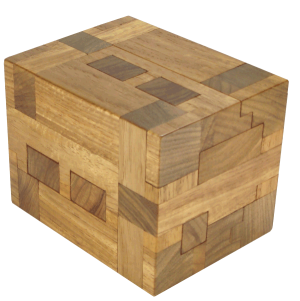Helix the Burr interlocking burr puzzle
21 December 2004Sold Out Limited Edition 2004 Set of 30. Original Price: AU$310.00 (AU$281.82 ex Australian Tax) This puzzle resold at Baxterweb Auction site June 2008 for…


There are 22 pieces to this extremely difficult caged burr puzzle designed by Goh Pit Khiam.
Pit Khiam was playing with Bill Cutler’s Binary Burr (First Prize: IPP Design Competition 2003) and wondered whether the ternary idea in Marcus Götz’s Crazy Elephant Dance (see the puzzle) puzzle could be adapted for a burr. After designing several prototypes, Ternary Burr was born. His initial designs allowed for only the key piece to be removed but this final design allows the cage to be disassembled as well once the “ring” pieces are removed.
Pit Khiam determined that the number of moves to remove the key piece for a simple “4 ring” puzzle is 75 based on these complex mathematical expressions. Let Tn be the minimum number of moves to remove the key piece for a puzzle with n “rings”. Tn can be defined recursively as Tn = 3Tn-1 – 2Tn-2 + 4 This leads to the following explicit expression for Tn: Tn = 6(2n) – 4n – 5
Complex mathematical theory aside – all we know is that it takes no less than 97 steps to completely disassemble this very difficult interlocking burr puzzle. That is 75 moves to remove the “bar” of the “4 ring” part of the puzzle, and an additional 22 steps to completely disassemble to frame.
A Chinese Ring Puzzle, a puzzle with a binary solution, with just 4 rings takes just 10 moves to complete so you can see that adapting the concept to a ternary puzzle in this way has significantly increased the difficulty.
The puzzle is made from Papua New Guinean Rosewood. The box is made to fit firmly. The 5 main working pieces (rings & key) are purposely made to move freely. These are very complex pieces and Brian did not want any doubt that force might be required; it is not.
Size: 130mm x 100mm x 100mm Solution: BurrTools file can be supplied when you buy the puzzle.
It seems Pit was also out to test the maker’s woodworking skills. Brian jokingly says “he must have thought of the most abstract notched pieces he could think of and then designed the puzzle around them”. There are over 90 check-outs and routed grooves to make the puzzle, many of which were milled from a single piece to minimise glue joints. Where Brian did have to glue pieces he tried to use it to strengthen the piece by laminating the wood.
Link to YouTube assembly of the puzzle. https://www.youtube.com/watch?v=FKavWv3Jin8&lc=UgxPc_tAIttiapYIJiR4AaABAg